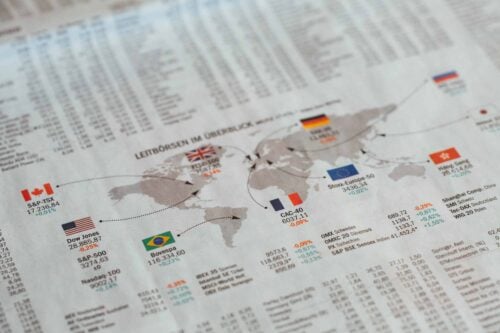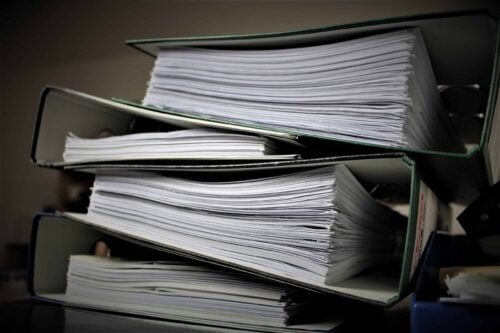Before you dive into how to pick an ETF, let’s learn what an ETF actually is.
An ETF is a way for investors to invest in a range of shares or bonds all in one package.
It stands for Exchange Traded Fund. ETFs usually target one specific market.
These markets can range from things like the FTSE 100 or the green energy market.
ETFs have management fees associated with them, so finding a low-cost one is important.
You should always make sure you choose an ETF from a good team with a solid performance.
ETFs can help you diversify your portfolio with limited hands-on management.
They are similar to index funds, as they both track the market’s performance.
ETFs usually have a low investment threshold, so it’s a great way for beginners to start investing.
They also minimize your risk as your investments are spread across several companies.
So, let’s learn how to pick an ETF.
How Do You Trade ETFs?

ETFs are traded on the stock market and work in a similar fashion to buying and selling stocks.
This separates ETFs from other funds as this means you can buy and sell them all day while the market is open.
For other funds, like index funds, trades can only be executed once per day.
When you go to buy or sell your ETF, there will be two price points available.
The first is an “ask price,” which is what you pay when you buy the stocks.
The second is the “bid price” which is the selling price of the ETF.
The “spread” is the difference between these two numbers. You can access ETFs through brokerage apps the same way you do for stocks.
Interested in trading ETFs? You can use Webull, a commission free investment platform! Learn more about Webull here.
Types of ETFs
At this point, you might be wondering how to pick an ETF when there are so many types out there. We’ll walk you through each one.
There are a variety of different ETFs available, and they all have different investment goals.
The assets carried in each ETF can also vary, although usually they are designed with a certain theme.
Some ETFs might carry all or some of the FTSE 100, while others might focus on specific industries like green energy, cannabis, or tech startups.
Below is a list of some ETF types, but these are not strict rules and actual ETFs can vary.
Stock ETFs
ETFs comprised of stocks are usually intended as a long-term growth opportunity.
They tend to be low risk as your investment spreads across many different stocks.
This could be preferable to individual stocks as it will limit your risk.
Bond ETFs
Bond ETFs are different from holding individual bonds as they do not mature.
Most consider bond ETFs to be an even lower risk than stock ETFs.
Individual bonds generate interest as the fund invests into them.
International ETFs

These are similar to stock ETFs but are for the international markets.
Ideal for creating a diverse portfolio, international ETFs could contain investments for a specific country or bloc of countries.
Sector ETFs
These are ETFs that focus on a specific sector or industry to invest in.
Sector ETFs may involve specific companies that work in the health care or the finance sectors for example.
Sector ETFs are great for investors looking to track business cycles.
Commodity ETFs
Commodity ETFs are for securities like gold, silver, and oil. You can choose one of these ETFs to have all these commodities in a single investment.
When choosing an ETF, you’ll need to make sure you know whether you are investing in the companies or the stockpile of product.
ETF Management Fees
ETFs are a good investment option because they typically have lower fees than index funds.
This fee does vary, so it’s worth checking before investing and paying more than you should be.
The expense ratio for the average ETF is 0.44%, meaning that for every $1000 you invest, there is an annual fee of $4.40.
Compared to an index fund that has an average cost of 0.74%, ETFs tend to be the cheaper option.
Alongside the management fees charged by the fund, there are additional charges to consider.
Depending on which brokerage you use, there may be commissions due when you buy and sell.
The commissions paid will vary between brokerages so it’s worth looking into before you start buying ETFs.
What Does An ETF Hold?

There are lots of different ETFs available and each one has different companies it invests in.
If you’re looking into ETFs, then you may want to look at their holdings.
Luckily ETFs are quite transparent so it’s easy to see how the ETF works.
The ETF might be targeting a particular region, sector, asset class, or index.
You may be able to find the information through your brokerage app.
The information is also available online through the ETFs website or a 3rd party website like www.etfdb.com.
Financial websites will also have this information and you should be able to find out more by typing in the symbol or name of the ETF.
Who Issues ETFs?
As with all investing, you will want to make sure you go with someone with a proven track record of success.
An ETF is only as good as the team that runs it.
A company must file a plan with the U.S. Securities and Exchange Commission in order to create, list, and invest in an ETF.
An ETF manager, also known as a sponsor, files this plan. The three top companies that create ETFs are iShares, Vanguard, and SPDR.
All three hold multiple ETFs and you can find them on all good brokerage apps.
Final Thoughts: How to Pick an ETF

ETFs represent a great way to diversify your portfolio while minimizing your risk.
Most ETFs run passively and track markets similar to how index funds work.
By investing in an ETF, you can spread your investment across multiple companies which lowers the risk of losing your investments.
Popular investments revolve around the FTSE 100 or the FTSE 250, as your money is invested across the top-performing stocks.
Depending on your investment strategy you may wish to look at the international market or niche down into certain sectors.
ETFs are a great addition to anyone’s investment portfolio.
And now you can get started with our guide on how to pick an ETF.


 Tags:
Tags:










